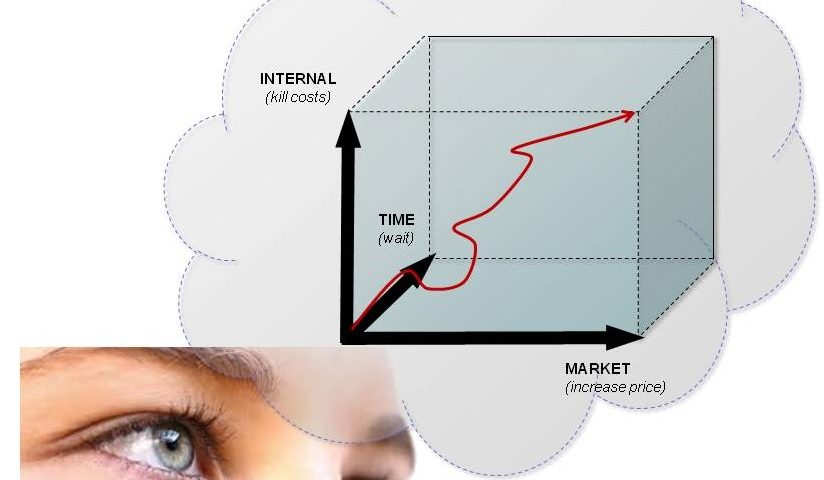
Business is changing, more and more computers are replacing humans at work, it is quicker in countries like France where heavier taxes and contributions weigh on salaries. This is a silent move which pushes people to part time jobs or disoccupation. The only spared workers are the high skilled one able to deal with technologies and business organisation1. Countries where consumption is a growth engine, are suffering as purchasing power is stalling or decreasing. Those turned toward exportation fare much better. But competition is hardening in a deflationary context.
CEO are struggling to maintain or reach an operating income level which is today less and less compatible with investors requiring more and more return on capital. They are also fighting for Revenue as customers are affected themselves by business environment changes. Crisis is a good scapegoat, it explains disoccupation and companies troubles. But now it is over and hangover is still there.
To hope to survive, companies need to transform themselves. Even so, not all will be able to proceed, only those which will get capital to finance the change and only those which will succeed into executing the change. Not much time will be left to start.
All of this would be new, unless consulting and editing companies have not rapped out Transformation for years.
What should be transformational directions ?
Toward customer
Today Customers expect low costs or sophisticated customized offerings which require pretty big marketing and supply chain transformation. Current trends are toward product as a service offerings. For instance Michelin has started a new business for which it does not offer tyres, but provide a rolled kilometer service with tyres. Areva is trying to transform itself to provide a megawatt production service and not nuclear plants. In some industries trends have been reverse. Mobile telecoms for instance started to sell phone and mobile services separately as customers require transparency on costs source.
Customer expect to reach offers or to be reached by any channel, anywhere, anytime on any terminal. He is mobile and he aspires to more and more liberty.
Toward offer and design to production
Marketing design should address product and services in an open environment. This means that services should be designed like products and mixed both in a package which should take in account customer environment and context. Another thing is that all these packages has to be customizable, functionaly, aesthetically, economically. As far as offers customisation grows, Marketing departments have pressure to set quick development and renewal business cycles.
This means that all processes from design to production have to be streamlined and automated as much as possible.
Toward supplier

As business should develop faster and faster or not at all otherwise, suppliers, partners, human resources have to be mobilised quickly. For this, the good way is not going so fast, but it is continuous relationships management with all of them in the aim of keeping them ready for the time you need them. This relationship activity is a lot of time spent in selection, contacts, presentation, documents exchange, pre agrements, planning, All this should be automated by approriate communication channels, social networks, markets plateforms.
Toward internal optimisation
Thinking about transformation is not enough without considering enterprise internal resources. Technology is able to handle more and more human tasks. If step one is obviously to streamline, to explicit and to organize internal processes, step two should be to increase automation and to decrease people. This is BPM architecture and technology. In the last stage, only very skilled workers will remain in entreprises, the ones being able to solve problems, to design reorganisations and to lead transformations. This is the lean revolution.
What business transformation means ?

First of all it should not be viewed as quick move but as a long term vision for which a clear strategy has to be defined with the aim of keeping consistent all enterprise operations as long as change is taking place. Then transformations are executed by enterprise people while they are doing day to day work. They expect that steps would be balanced for non disrupting business operations. More or less, final goal is known at one point, but it is not most important thing.
Today, tactic is more important than strategy because it is critical to know what, why, when and how instead to have a long term goal for which you don’t even know when you ‘ll reach it. Indeed Long term goals use to change along transformation is going on. Gartner calls it “Emergence”.
In such moving business environment, the way to start transformation is to agree on overall goal which should be to make a full fledged digital enterprise. This may be achieved by defining principles and high level statements which will be used to drive transformation. This would be a kind of charter approved by enterprise management. Then, a management team has to be settled with the responsibility to launch and fuel the dynamic. This team should gather enterprise designers along with program managers. Their role would be to define year to year transformation roadmaps with business and support functions according to yearly strategy, and to organize programs to be launched for implementing it. These program managers would supervise project managers who are for some of them in IT Organisation and others in Business Organisation.
Enterprise designers identify business gains, transformation benefits and provide design approaches while Project office allocates competences, resources, manage development and roll out process, manage sourcing, start and conduct programs. Beside, quality management office define organisation and process rules to deliver quality goods and services. This new team is a kind of nervous center connected to all enterprise functions helping them to find the right place in the ongoing transformation, achieving their own objectives and controlling that each of them succeed in their role.
This team would be a new support direction, this will avoid struggling between existing ones, like Marketing and IT which never enough good to execute.
Success is critical
In a business context where capital is a resource hard to acquire and therefore required to transform, it is important for enterprises to succeed and to get as soon as possible benefits of tranformation. This is far from easy since only 30% of projects are deemed successful, others being stopped or over budget and over delay. This means that only healthy companies can afford to launch transformation, others are on the edge, walking tactically around traps and seing thier market shrinking more less quickly. Acquiring tranformation capabilities and improving project success rate is an urgent and mandatory goal for any company of today.
Yet, it should not be difficult to launch as it does not require investment at start, it is first matter of people and competencies. Today, competences exist but are broken up according to projects requirements : architects, project managers, business analysts. Tomorrow for tranformation you need more breath than depth : architects with project management and business competences, program managers with business competences, quality managers with architecture and business competences. Once settled, transformation team would help company Directions to find the best balance between investment and benefits. And it will launch projects in a better context for getting them successful.
Finally, companies would find a more efficient use of capital, and would be more credible by investors in so that would be easier for them to get more capital. This is a kind of vertuous cycle which lead as a whole companies to an efficient economy.

Enterprise cloud connects with customer clouds
1Race Against The Machine: How the Digital Revolution is Accelerating Innovation, Driving Productivity, and Irreversibly Transforming Employment and the Economy –
Erik Brynjolfsson, Andrew McAfee

